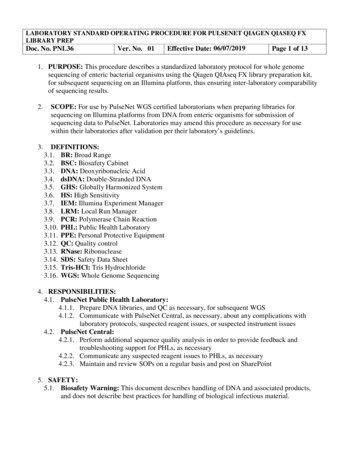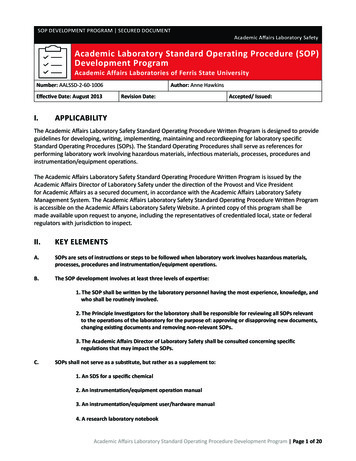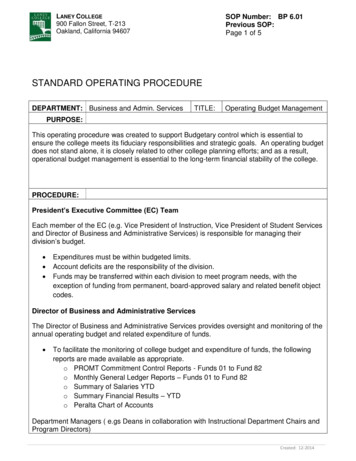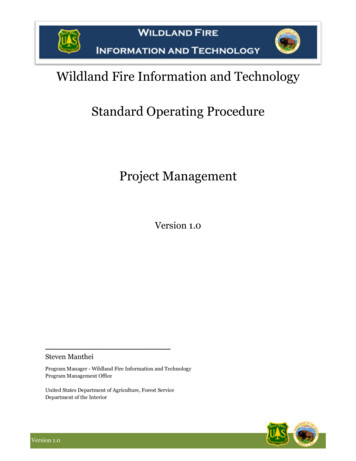
Transcription
LABORATORY STANDARD OPERATING PROCEDURE FOR PULSENET QIAGEN QIASEQ FXLIBRARY PREPDoc. No. PNL36Ver. No. 01Effective Date: 06/07/2019Page 1 of 131. PURPOSE: This procedure describes a standardized laboratory protocol for whole genomesequencing of enteric bacterial organisms using the Qiagen QIAseq FX library preparation kit,for subsequent sequencing on an Illumina platform, thus ensuring inter-laboratory comparabilityof sequencing results.2.3.SCOPE: For use by PulseNet WGS certified laboratorians when preparing libraries forsequencing on Illumina platforms from DNA from enteric organisms for submission ofsequencing data to PulseNet. Laboratories may amend this procedure as necessary for usewithin their laboratories after validation per their laboratory’s guidelines.DEFINITIONS:3.1. BR: Broad Range3.2. BSC: Biosafety Cabinet3.3. DNA: Deoxyribonucleic Acid3.4. dsDNA: Double-Stranded DNA3.5. GHS: Globally Harmonized System3.6. HS: High Sensitivity3.7. IEM: Illumina Experiment Manager3.8. LRM: Local Run Manager3.9. PCR: Polymerase Chain Reaction3.10. PHL: Public Health Laboratory3.11. PPE: Personal Protective Equipment3.12. QC: Quality control3.13. RNase: Ribonuclease3.14. SDS: Safety Data Sheet3.15. Tris-HCl: Tris Hydrochloride3.16. WGS: Whole Genome Sequencing4. RESPONSIBILITIES:4.1. PulseNet Public Health Laboratory:4.1.1. Prepare DNA libraries, and QC as necessary, for subsequent WGS4.1.2. Communicate with PulseNet Central, as necessary, about any complications withlaboratory protocols, suspected reagent issues, or suspected instrument issues4.2. PulseNet Central:4.2.1. Perform additional sequence quality analysis in order to provide feedback andtroubleshooting support for PHLs, as necessary4.2.2. Communicate any suspected reagent issues to PHLs, as necessary4.2.3. Maintain and review SOPs on a regular basis and post on SharePoint5. SAFETY:5.1. Biosafety Warning: This document describes handling of DNA and associated products,and does not describe best practices for handling of biological infectious material.
LABORATORY STANDARD OPERATING PROCEDURE FOR PULSENET QIAGEN QIASEQ FXLIBRARY PREPDoc. No. PNL36Ver. No. 01Effective Date: 06/07/2019Page 2 of 135.2. Chemical Safety Warning: Take proper precautions, and wear appropriate PPE whenhandling potentially hazardous chemicals. Ensure that chemicals, spent containers, andunused contents are disposed of in accordance with governmental safety standards.5.2.1. Qiagen QIAseq FX Library Prep Kit: See Qiagen SDSs for additional information.Take proper precautions and wear appropriate PPE when handling reagents. DNA Ligase Buffer (5X): GHS Category 3 for respiratory irritation6. REAGENTS: Store reagents at room temperature (20-25 C) unless stated otherwise6.1. Agencourt AMPure XP for PCR Purification (5ml, Beckman Cat# A63880 or 60 ml,Beckman Cat#A63881). Store at 2-8 C.6.2. Ethanol, molecular-grade, 95-100% (Fisher Cat# BP2818-500 or equivalent)6.3. Ethanol, lab-grade, 70% or equivalent for disinfection purposes (Fisher Cat# 04-355-309 orequivalent)6.4. Tris-HCl, 1M, pH 8.0 (Sigma-Aldrich, Cat# T3038-1L or equivalent). Store at 2-8 C.6.5. Qiagen QIAseq FX Library Prep Kit (96 samples, Qiagen Cat# 180475 or 24 samples,Qiagen Cat# 180473). Store at -25 to -15 C FX Enzyme Mix (Violet Cap) FX Buffer, 10X (Blue Cap) FX Enhancer (Black Cap) DNA Ligase (Red Cap) DNA Ligase Buffer, 5X (Yellow Cap) Adapter Plate RNase-Free Water (Clear Cap) HiFi PCR Master Mix, 2X (Green Cap) Primer Mix Illumina Libra. Amp (Clear Cap)6.6. Qubit dsDNA High Sensitivity (HS) Assay kit (100 samples, ThermoFisher Cat# Q32851or 500 samples, ThermoFisher Cat# Q32854) dsDNA HS Reagent. Protect from light. dsDNA HS Buffer dsDNA HS Standard #1. Store at 2-8 C dsDNA HS Standard #2. Store at 2-8 C7. SUPPLIES:7.1. Conical tubes, 10 ml and/or 15 ml (Fisher Scientific Cat# 14-959A and/or Fisher Cat# 14959-53A or equivalent)7.2. Ice7.3. Microcentrifuge tubes, 1.5 ml, sterile (ThermoFisher Cat# AM12400 or equivalent)7.4. Microseal A film (BioRad Cat# MSA-5001 or equivalent)7.5. Microseal B adhesive seal (BioRad Cat# MSB-1001 or equivalent)7.6. PCR plates, skirted, hard shell low profile, thin-wall, 96 well (BioRad Cat# HSP-9601 orequivalent)7.7. Pipette tips, sterile, filtered: 20 µl, 200 µl and 1000 µl volumes (Rainin Cat# 17001865,17001863 & 17001864 or equivalent)
LABORATORY STANDARD OPERATING PROCEDURE FOR PULSENET QIAGEN QIASEQ FXLIBRARY PREPDoc. No. PNL36Ver. No. 01Effective Date: 06/07/2019Page 3 of 137.8. Qubit Assay Tubes (ThermoFisher Cat# Q32856 or equivalent (clear, thin-wall 0.5-ml PCRtubes))7.9. Serological pipets, 1 ml to 10 ml volumes (various catalog numbers)7.10. Solution basins, sterile (Fisher Scientific Cat# 13-681-504 or equivalent)7.11. OPTIONAL: Deepwell storage “MIDI” plates, 96 well (Fisher Cat# AB-0859 orequivalent)8. EQUIPMENT:8.1. Ice buckets/containers8.2. Magnetic Stand-96 (ThermoFisher Cat# AM10027 or equivalent)8.3. Microcentrifuge for quick spins8.4. Micropipettes, capable of volumes from 1 µl to 1000 µl. Single and multichannel (20 µl and100µl volumes).NOTE: Two sets of pipettes are suggested; one for working with pre-amplified product andreagents and one set for working with post-PCR amplified product and reagents.8.5. Microplate centrifuge8.6. Pipet-Aid8.7. Qubit 2.0 or 3.0 Fluorometer, or equivalent for quantification of dsDNA8.8. Thermal cycler, capable of accepting a 96-well plate, with heated lid8.9. Vortex9. PROCEDURE:NOTE: Ensure that DNA going into library preparation has been assessed for quality. The260/280 value should be between 1.75 and 2.05. See PNL33 for more information.9.1. Preparation of 10mM Tris-HCl pH 8.09.1.1. Add 10 ml of 1M Tris-HCl, pH 8.0 to 990 ml of molecular-grade water.9.1.2. Invert several times to mix.9.1.3. Store at 2-8 C for up to one year (indicate the initial, date of preparation, and date ofexpiry on the bottle).9.2. Preparation of Sequencing Workbook: The steps for Sample Plate and Sample Sheetsetup in IEM or LRM on the instrument can be completed at any point in this protocol, butmust be performed prior to the start of the run. However, it is recommend to create theSample Plate and Sample Sheet at the beginning of library prep.9.2.1. Prepare the “Initial Dilution” tab of the QIAseq FX Library Prep Workbook asdescribed below:NOTE: The workbook is designed with the following color scheme, in general: Yellow fields should be filled in Blue fields contain formulas, which will autopopulate, and should not bealtered9.2.2. Enter the Run ID in C2, C3, and C4: labID-MXXXX-YYMMDD.9.2.3. Enter the Library Prep date (C5) and Technician (C6).9.2.4. Enter (or select from the dropdown) Sequencing Kit Type/Chemistry (C7).9.2.5. Enter the Sample name in appropriate location (Column B). This is the identifierentered in the PulseNet Key field in the BioNumerics database.
LABORATORY STANDARD OPERATING PROCEDURE FOR PULSENET QIAGEN QIASEQ FXLIBRARY PREPDoc. No. PNL36Ver. No. 01Effective Date: 06/07/2019Page 4 of 139.2.6. Determine which set of indices will be used and enter (or select from the dropdown)the well position from the index plate, into column E of the workbook.NOTE: It is recommended to not use the same index pairs within 2 consecutive runson the same sequencer to reduce the amount of carryover. See Appendix PNL36-1for QIAseq FX Indices Tracking Worksheet.9.2.7. Enter the 260/280 Nanodrop value into Column F.9.2.8. Enter the Genome Size Estimate (based on Table 1 below) into Column G.OrganismE. coli spp. & Shigella spp.Salmonella ssp.Vibrio spp.Listeria monocytogenesCampylobacter spp.Estimated Genome Size (million bases, Mb)55531.6Table 1. Estimated genome size (in Mb) by organism9.2.9. Confirm that the number of isolates on the run is appropriate for the capacity of thesequencing reagent kit to be used. The sum of the genome sizes (in Mb) for thesamples on the run (from column G, found in cell G44 of the workbook) will givethe estimated DNA load of the run. This cannot exceed the DNA load allowance ofthe reagent kit to be used. The DNA load for MiSeq cartridges can be found in Table2 below.MiSeq Cartridgev2 300v2 500*v3 600, mixed runs*v3 600, E. coli/Shigella*Micro (300)*Nano (500)DNA Load (Mb)801002001753513Table 2. Estimated DNA Load (in Mb) Capacity for Illumina Sequencing Kits.*DNA capacity for v3 600, Micro and Nano kits are still being evaluated. Current recommendations are basedon Nextera XT and can be likely slightly increased.9.2.10. Enter the concentration of extracted DNA into Column H.NOTE: PulseNet has standardized the starting mass of DNA to 50 ng.9.3. Normalization and fragmentation of DNA9.3.1. Thaw FX Buffer (10X) and FX Enzyme Mix on ice.9.3.2. Ensure the pre-programmed thermal cycler is turned on prior to beginningfragmentation, as some steps are time sensitive.9.3.3. Label a 96-well PCR plate, or equivalent, with Run ID.9.3.4. Add molecular-grade water (Column J in Initial Dilution) to each sample well.9.3.5. Add DNA (Column I in Initial Dilution) to the molecular-grade water and mix well.
LABORATORY STANDARD OPERATING PROCEDURE FOR PULSENET QIAGEN QIASEQ FXLIBRARY PREPDoc. No. PNL36Ver. No. 01Effective Date: 06/07/2019Page 5 of 139.3.6. Add 5 µl of FX Buffer (10X) to each sample well.9.3.7. Add 10 µl of FX Enzyme Mix to each well and mix well by gently pipetting 5-10times using a multichannel pipette.NOTE: Fragmentation is time sensitive. It is important to perform step 9.3.7.quickly.9.3.8. Seal the plate with Microseal A (or equivalent) and run the following preprogrammed settings on a thermal cycler with a heated lid:Step1: 32 C for 4 minutesStep2: 65 C for 30 minutesStep 3: Hold at 4 C(50 µl total volume)NOTE1: It is recommended to pre-program a thermal cycler for this purpose.NOTE2: This is not a recommended stopping point in the procedure and AdapterLigation should be commenced once the samples have reached 4 C.9.4. Adapter Ligation9.4.1. Thaw DNA Ligase Buffer (5X) and DNA Ligase on ice.9.4.2. Thaw adapter plate on ice and centrifuge at 800-1200 rpm (or 280 x g) for 30seconds, if needed.9.4.3. Prepare adapter ligation master mix:ReagentVolume per SampleDNA Ligase Buffer, 5XDNA LigaseRNase-Free water20 µl10 µl15 µlTable 3: Reagent volumes per sample for adapter ligation.NOTE: It is recommended to increase the number of samples during master mixcalculation by 1-2 to ensure sufficient master mix volume. See workbook (Cells J5052) for reagent volume.9.4.4.9.4.5.9.4.6.9.4.7.Gently vortex and quick spin the adapter ligation master mix.When samples have reached 4 C, remove the plate from the thermal cycler.Add 45 µl of prepared adapter ligation master mix to each sample well.Add 5 µl of appropriate index (Column E in Initial Dilution) from the index plate toeach sample well and mix well by gently pipetting 10-15 times using a multichannelpipette.9.4.8. Seal the plate with Microseal A (or equivalent) and incubate the plate at 20 C for 15minutes, followed by a 4 C hold (volume is 100 µl) on a thermal cycler with noheated lid.NOTE1: It is recommended to pre-program a thermal cycler for this purpose.
LABORATORY STANDARD OPERATING PROCEDURE FOR PULSENET QIAGEN QIASEQ FXLIBRARY PREPDoc. No. PNL36Ver. No. 01Effective Date: 06/07/2019Page 6 of 13NOTE2: This is not a recommended stopping point in the procedure and PostLigation Clean-Up should be commenced once the samples have reached 4 C.9.5. Post-Ligation Clean-Up9.5.1. Before starting, prepare reagents:9.5.1.1.Dilute fresh 80% ethanol sufficient for all samples:NOTE: Prepare 1 ml of 80% ethanol for each sample for two complete beadclean-up.ReagentVolume persample100% ethanol0.8 mlMolecular-grade water 0.2 mlExample: 20samples16 ml4 mlTable 4: Reagent volumes per sample for 80% ethanol.9.5.1.2.Bring AMPure XP beads and 10mM Tris-HCl to room temperature.9.5.2. If needed, centrifuge the PCR plate at 800-1200 rpm (or 280 x g) for approximately30 seconds to collect condensation.9.5.3. Vortex the AMPure XP beads until well suspended (15 – 30 seconds).9.5.4. To each 100 µl of product, add 80 µl (0.8x volume) of AMPure XP.NOTE1: Deepwell MIDI plate may be used for the procedure.NOTE2: Avoid bead carryover by confirming no droplets are on the pipette tip. Thiswill affect the ratio of beads to PCR reaction, which affects fragment size selection.9.5.5. Gently pipette up and down 10-15 times to mix.9.5.6. Incubate at room temperature for at least 5 minutes.9.5.7. Place the plate on the magnetic stand for a minimum of 5 minutes or until thesupernatant has cleared.9.5.8. With the plate still on the magnetic stand, carefully remove and discard thesupernatant.NOTE: If any beads are inadvertently aspirated into the tips, dispense the beadsback into the wells and let the plate rest on the magnetic stand for another 2 minutesor until the supernatant has cleared.9.5.9. With the plate still on the magnetic stand, wash the beads by adding 200 µl of freshlyprepared 80% ethanol to each well.NOTE: Do not resuspend the beads at any point during the wash steps or removethe plate from the magnetic stand.9.5.10. Incubate the plate on the magnetic stand for 30 seconds, then carefully remove anddiscard the supernatant.9.5.11. With the plate still on the magnetic stand, perform a second 80% ethanol wash.9.5.12. Incubate the plate on the magnetic stand for 30 seconds, then carefully remove anddiscard the supernatant.9.5.13. With the plate on the magnetic stand, use a low volume pipette tip to remove anyremaining ethanol droplets and allow the beads to air-dry for up to 3 minutes.
LABORATORY STANDARD OPERATING PROCEDURE FOR PULSENET QIAGEN QIASEQ FXLIBRARY PREPDoc. No. PNL36Ver. No. 01Effective Date: 06/07/2019Page 7 of 13NOTE: Exceeding the maximum drying period (3 minutes) could make resuspensionof DNA fragments difficult. Over-drying is indicated by cracks in the bead pellets.9.5.14. Remove the plate from the magnetic stand.9.5.15. Add 53 µl of 10mM Tris-HCl to each well.9.5.16. Gently pipette up and down at least 10 times to mix, ensuring the beads arecompletely resuspended, and changing tips after each well.9.5.17. Incubate at room temperature for 5 minutes.9.5.18. Place the plate on the magnetic stand for at least 2 – 3 minutes or until thesupernatant has cleared.9.5.19. Carefully transfer 50 µl of the supernatant from the plate to a new set of wells forsecond post-ligation clean-up.9.5.20. To each 50 µl of product, add 50 µl (1x volume) of AMPure XP beads.NOTE1: Deepwell MIDI plate may be used for the procedure.NOTE2: Avoid bead carryover by confirming no droplets are on the pipette tip. Thiswill affect the ratio of beads to PCR reaction, which affects fragment size selection.9.5.21. Gently pipette up and down 10-15 times to mix.9.5.22. Incubate at room temperature for at least 5 minutes.9.5.23. Place the plate on the magnetic stand for a minimum of 5 minutes or until thesupernatant has cleared.9.5.24. With the plate still on the magnetic stand, carefully remove and discard thesupernatant.NOTE: If any beads are inadvertently aspirated into the tips, dispense the beadsback into the wells and let the plate rest on the magnetic stand for another 2 minutesor until the supernatant has cleared.9.5.25. With the plate still on the magnetic stand, wash the beads by adding 200 µl of freshlyprepared 80% ethanol to each well.NOTE: Do not resuspend the beads at any point during the wash steps or removethe plate from the magnetic stand.9.5.26. Incubate the plate on the magnetic stand for 30 seconds, then carefully remove anddiscard the supernatant.9.5.27. With the plate still on the magnetic stand, perform a second 80% ethanol wash.9.5.28. Incubate the plate on the magnetic stand for 30 seconds, then carefully remove anddiscard the supernatant.9.5.29. With the plate on the magnetic stand, use a low volume pipette tip to remove anyremaining ethanol droplets and allow the beads to air-dry for up to 3 minutes.NOTE: Exceeding the maximum drying period (3 minutes) could make resuspensionof DNA fragments difficult. Over-drying is indicated by cracks in the bead pellets.9.5.30. Remove the plate from the magnetic stand.9.5.31. Add 27 µl of 10mM Tris-HCl to each well.9.5.32. Gently pipette up and down at least 10 times to mix, ensuring the beads arecompletely resuspended, and changing tips after each well.9.5.33. Incubate at room temperature for 5 minutes.9.5.34. Place the plate on the magnetic stand for at least 2 – 3 minutes or until thesupernatant has cleared.
LABORATORY STANDARD OPERATING PROCEDURE FOR PULSENET QIAGEN QIASEQ FXLIBRARY PREPDoc. No. PNL36Ver. No. 01Effective Date: 06/07/2019Page 8 of 139.5.35. Carefully transfer 23.5 µl of the supernatant from the plate to a new set of wells foramplification.9.6. Amplification of DNA9.6.1. Thaw HiFi PCR Master Mix (2X) and Primer Mix on ice.9.6.2. Add 25 µl of HiFi PCR Master Mix (2X) to each well containing 23.5 µl of cleanadapter-ligated DNA.9.6.3. Add 1.5 µl of Primer Mix to each well and mix well by gently pipetting 10-15 timesusing a multichannel pipette.9.6.4. Seal the plate with Microseal A or equivalent, and run the following preprogrammed settings on a thermal cycler with a heated lid (100 C):Step 1: 98 C for 2 minutesStep 2: 8 cycles98 C for 20 seconds60 C for 30 seconds72 C for 30 secondsStep 3: 72 C for 1 minuteStep 4: Hold at 4 CTotal volume: 50 µl9.6.5. Centrifuge plate for at 280 x g for 30 seconds.NOTE: This is a safe stopping point. The plate may be sealed with Microseal B orequivalent, and stored at 2 C to 8 C for up to 2 days.9.7. Post-Amplification Clean-UpNOTE: The steps listed below are critical for efficient size selection, product recovery andthus cluster generation and sequencing. Always check pipette tips for correct volumes andto ensure that no beads have accidentally been aspirated. If beads have been aspirated orthe bead pellet is disturbed, allow the pellet to reform (3-5 minutes on the magnet) andrepeat the step.9.7.1. Before starting, prepare reagents:9.7.1.1.Dilute fresh 80% ethanol sufficient for all samples:ReagentVolume persample100% ethanol0.4 mlMolecular-grade water 0.1 mlExample: 20samples8 ml2 mlTable 5: Reagent volumes per sample for 80% ethanol.9.7.1.2.Bring AMPure XP beads and 10mM Tris-HCl to room temperature.9.7.2. If needed, centrifuge the PCR plate at 800-1200 rpm (or 280 x g) for approximately30 seconds to collect condensation.
LABORATORY STANDARD OPERATING PROCEDURE FOR PULSENET QIAGEN QIASEQ FXLIBRARY PREPDoc. No. PNL36Ver. No. 01Effective Date: 06/07/2019Page 9 of 139.7.3. Vortex the AMPure XP beads until well suspended (15 – 30 seconds).9.7.4. Transfer 40 µl of the PCR product to a new set of wells.NOTE: Deepwell MIDI plate may be used for the procedure.9.7.5. Add 16 µl (0.4x volume) of AMPure XP beads to each well.NOTE: Avoid bead carryover by confirming no droplets are on the pipette tip. Thiswill affect the ratio of beads to PCR reaction, which affects fragment size selection.9.7.6. Gently pipette up and down 10-15 times to mix.9.7.7. Incubate at room temperature for at least 5 minutes.9.7.8. Place the plate on the magnetic stand for a minimum of 3 minutes or until thesupernatant has cleared.9.7.9. With the plate still on the magnetic stand, carefully remove 50 µl of the supernatantand place in a new set of wells. Remove the plate from the magnetic stand for thesecond bead addition.NOTE: If any beads are inadvertently aspirated into the tips, dispense the beadsback into the CAA and let the plate rest on the magnetic stand for another 2 minutesor until the supernatant has cleared.9.7.10. Add 5 µl (0.1x) of AMPure XP beads to the wells containing the 50 µl ofsupernatant.9.7.11. Gently pipette up and down 10-15 times to mix.9.7.12. Incubate at room temperature for at least 5 minutes.9.7.13. Place the plate on the magnetic stand for a minimum of 2 minutes or until thesupernatant has cleared.9.7.14. With the plate still on the magnetic stand, carefully remove and discard thesupernatant.NOTE: If any beads are inadvertently aspirated into the tips, dispense the beadsback into the wells and let the plate rest on the magnetic stand for another 2 minutesor until the supernatant has cleared.9.7.15. With the plate still on the magnetic stand, wash the beads by adding 200 µl of freshlyprepared 80% ethanol to each well.NOTE: Do not resuspend the beads at any point during the wash steps or removethe plate from the magnetic stand.9.7.16. Incubate the plate on the magnetic stand for 30 seconds, then carefully remove anddiscard the supernatant.9.7.17. With the plate still on the magnetic stand, perform a second 80% ethanol wash.9.7.18. Incubate the plate on the magnetic stand for 30 seconds, then carefully remove anddiscard the supernatant.9.7.19. With the plate on the magnetic stand, use a low volume pipette tip to remove anyremaining ethanol droplets and IMMEDIATELY remove the plate from themagnetic stand.NOTE: The bead pellets are small and do not need additional drying time.9.7.20. Add 33 µl of 10mM Tris-HCl to each well.9.7.21. Gently pipette up and down at least 10 times to mix, ensuring the beads arecompletely resuspended, and changing tips after each well.9.7.22. Incubate at room temperature for 5 minutes.
LABORATORY STANDARD OPERATING PROCEDURE FOR PULSENET QIAGEN QIASEQ FXLIBRARY PREPDoc. No. PNL36Ver. No. 01Effective Date: 06/07/2019Page 10 of 139.7.23. Place the plate on the magnetic stand for at least 2 minutes or until the supernatanthas cleared.9.7.24. Transfer 30 µl of the supernatant to a new PCR plate – This is the final product.NOTE1: Qubit should be performed at this point and results recorded in Column Eof the Normalization and Pooling tab of the Workbook.NOTE2: The DNA concentration after post-PCR clean-up can be between 5 ng/µland 20 ng/µl.NOTE3: The ideal minimum concentration required for sequencing is 2 nM.However, a sample can still be run if it is below the ideal concentration as long asDNA is detected by the Qubit. These low concentration samples should not be dilutedprior to pooling libraries.NOTE4: If 25% or more of the samples are below the ideal minimum concentration,consider delaying the run (depending epidemiological importance of the isolate orwhether it is associated with an outbreak investigation), and repeat the library prepprocedure for samples with a low concentration.This is a safe stopping point. The plate may be sealed with Microseal B or equivalent andstored at -20 C until use, or for long-term storage.9.8. Normalizing and Pooling the Libraries9.8.1. If libraries in the PCR plate/tubes are frozen, thaw on ice and centrifuge at 800 –1200 rpm (or 280 x g) for 30 seconds.9.8.2. For each library, dispense 10mM Tris-HCl (diluent) into a clean well of the PCRplate according to the volumes listed in Column H of the Normalization and Poolingtab of the Workbook.9.8.3. Ensure that DNA is well mixed, then transfer the appropriate volume of each library(Column G of the Normalization and Pooling tab) to the corresponding wellcontaining 10mM Tris-HCl to obtain the desired concentration (2nM, 3nM or 4nM).NOTE: The recommended library concentrations are 2 – 4 nM for MiSeq, 2 nM forMiniSeq, and 1 nM for ISeq. Adjust the loading concentration as needed whendiluting the denatured pooled library in PNL38.NOTE2: The recommended loading concentration for QIAseq FX libraries is 8 – 10pM on the MiSeq.9.8.4. Mix the dilutions by pipetting up and down 5-7 times with a multichannel pipet.9.8.5. For each sample library, transfer the volume listed in the “Pooling Volume” column(Column J in Normalization and Pooling tab) into a single well on the PCR plate orin a new 0.2 ml tube for a total pooled volume of 50 µl.NOTE: The pooling factor is based on the genome size. When genomes of differentsizes are run together, the amount of each single library is added proportionately togenome size to reduce the over-representation of small genomes in the pooledlibrary.9.8.6. Mix the pooled library by pipetting up and down 10 times.
LABORATORY STANDARD OPERATING PROCEDURE FOR PULSENET QIAGEN QIASEQ FXLIBRARY PREPDoc. No. PNL36Ver. No. 01Effective Date: 06/07/2019Page 11 of 13NOTE: The libraries are now ready for sequencing. Please proceed to theappropriate instrument sequencing SOP for instructions to denature and dilute thepool to the proper loading concentration.10. FLOW CHART: N/A11. RELATED DOCUMENTS:Document NumberPNL33PNL38PNQ07PNL36.W1TitleDNA Extraction and QC SOPSequencing on the MiSeq SOPIllumina MiSeq Data QCQIAseq FX Library Prep Workbook12. REFERENCES:12.1. Qiagen, QIAseq FX DNA Library Handbook. (Doc No. 1102703). May etail?id 6f298961-8e3d-4235-b5b15a3a3394dbb0&lang en12.2. Qiagen, MSDS QIAseq FX DNA Library /result htmllist.jsp?P LANGU E&PSYS 4&P SSN 42571&C001 MSDS&C700 KIT&C007 PROD&C100 QIA&C002 US&C013 18047513. CONTACTS:13.1.PulseNet NGS Lab troubleshooting account:PulseNetNGSLab@cdc.gov14. APPENDICES:14.1.PNL36-1: QIAseq FX Indices Tracking Worksheet15. AMENDMENTS:15.1.4/24/19 New Document
LABORATORY STANDARD OPERATING PROCEDURE FOR PULSENET QIAGEN QIASEQ FXLIBRARY PREPDoc. No. PNL36Ver. No. 01Effective Date: 06/07/2019Page 12 of 1316. APPROVAL SIGNATURES:Digitally signed by Yoo Jin Joung Yoo Jin Joung -SS (Affiliate)Date: 2019.06.04 07:22:13 -04'00'06/04/2019Approved By: (Affiliate)Date:Authorsigned by Patricia C. LafonPatricia C. Lafon -S Digitally-S (Affiliate)06/07/2019Date: 2019.06.07 14:21:09 -04'00'(Affiliate)Approved By:Date:PulseNet QA/QC PersonnelApproved By: N/A Date: N/APulseNet Outbreak Detection and Surveillance Unit ChiefApproved By: N/A Date: N/APulseNet PFGE Reference Unit ChiefTreesDate: 2019.06.04 10:42:29 -04'00' Date: 06/04/2019Approved By: EijaPulseNet Next Generation Subtyping Methods Unit ChiefDigitally signed by Eija TreesDigitally signed by Efrain M. Ribot -06/07/2019Efrain M. Ribot -S SDate: 2019.06.07 13:47:34 -04'00' Date:Approved By:PulseNet Reference Outbreak Surveillance Team Lead
LABORATORY STANDARD OPERATING PROCEDURE FOR PULSENET QIAGEN QIASEQ FXLIBRARY PREPDoc. No. PNL36Ver. No. 01Effective Date: 06/07/2019Appendix PNL36-1:Example of QIAseq FX Indices Tracking WorksheetPage 13 of 13
Qubit dsDNA High Sensitivity (HS) Assay kit (100 samples, ThermoFisher Cat# Q32851 or 500 samples, ThermoFisher Cat# Q32854) dsDNA HS Reagent. Protect from light. dsDNA HS Buffer dsDNA HS Standard #1. Store at 2-8 C dsDNA HS Standard #2. Store at 2-8 C. 7. SUPPLIES: 7.1. Conical tubes , 10 ml and/or 15 ml (Fisher Scientific .











